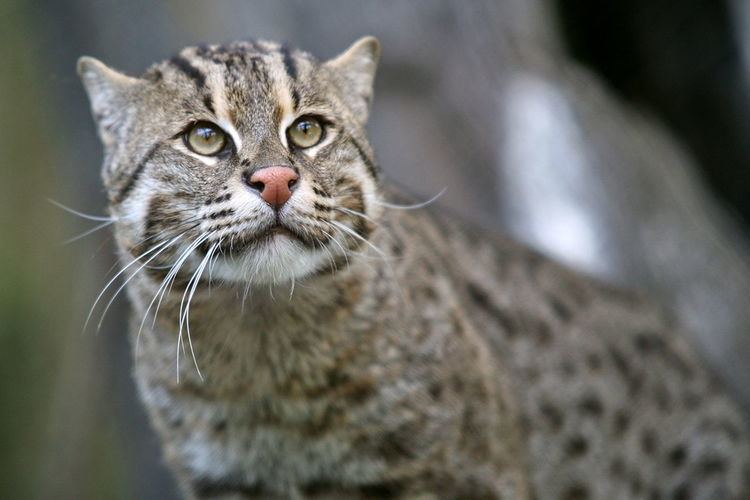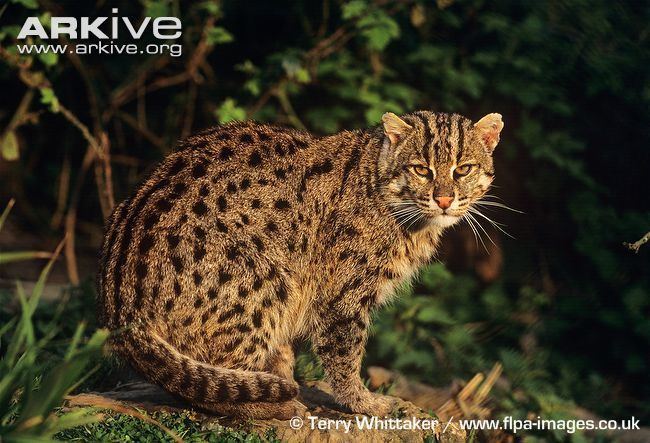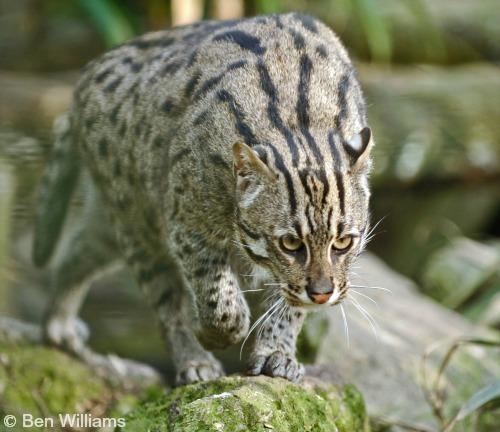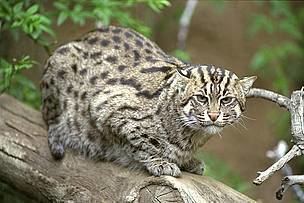Scientific name Prionailurus viverrinus | ||
 | ||
Similar Asian golden cat, Flat‑headed cat, Prionailurus, African golden cat, Black‑footed cat | ||
Lek the fishing cat gets a new home
The fishing cat (Prionailurus viverrinus) is a medium-sized wild cat of South and Southeast Asia. Since 2016, it is listed as Vulnerable on the IUCN Red List. Fishing cat populations are threatened by destruction of wetlands and declined severely over the last decade. Fishing cats live foremost in the vicinity of wetlands, along rivers, streams, oxbow lakes, in swamps and mangroves.
Contents
- Lek the fishing cat gets a new home
- 10 week old fishing cats
- Characteristics
- Distribution and habitat
- Ecology and behavior
- Reproduction and development
- Threats
- Conservation
- In captivity
- Local names
- References

The fishing cat is the state animal of West Bengal.
10 week old fishing cats
Characteristics

Fishing cats are the largest of the Prionailurus cats. They are about twice the size of a domestic cat and have a stocky, muscular build with medium to short legs. The coarse fur is olive-grey with dark spots arranged in horizontal streaks running along the length of the body. The face is elongated with a distinctly flat nose and ears set far back on the head. The underside is white, and the back of the ears are black with central white spots. There are a pair of dark stripes around the throat, and a number of black rings on the tail. Their head-to-body length typically ranges from 57–78 cm (22–31 in), with a short tail of 20–30 cm (7.9–11.8 in), which is one half to one third the length of the rest of the animal. They weigh from 5–16 kg (11–35 lb). The face is spotted and the ears are short and rounded. Black spots run longitudinally across the body, and six to eight dark stripes run from behind the eyes to the nape. The underside fur is longer and often overlaid with spots.

Their feet are less completely webbed than those of leopard cats, their claws incompletely sheathed. Webbed feet have often been noted as a characteristic of the fishing cat, but the webbing beneath the toes is not much more developed than that of a bobcat.
Distribution and habitat

The fishing cat is broadly but discontinuously distributed in Asia, and is primarily found in the Terai region of the Himalayan foothills in India and Nepal, in eastern India, Bangladesh and Sri Lanka. There are no confirmed records from Peninsular Malaysia, Vietnam and Laos.

In India, the presence of fishing cats has been documented in Ranthambhore Tiger Reserve, in Sur Sarovar Bird Sanctuary, outside protected areas in West Bengal, in and around Krishna Wildlife Sanctuary, in Coringa Wildlife Sanctuary and adjoining reserve forests in Andhra Pradesh.
Populations have also been documented along the coast in Thailand. Fishing cats were the least detected cats with only six photos obtained altogether in Kaeng Krachan National Park, Khao Sam Roi Yot National Park and Thale Noi Non-Hunting Area. In March 2003, a single fishing cat was photographed by a camera trap in Kulen Promtep Wildlife Sanctuary, northern Cambodia. In 2008, a fishing cat kitten was found in Botum-Sakor National Park, southwest Cambodia. In 2015, fishing cats were also recorded in a coastal wetland in Cambodia.
In 2012, a fishing cat was recorded in Sindh Province, Pakistan.
Reports in Bangladeshi newspapers indicate that fishing cats live in all divisions of Bangladesh but are severely threatened; villagers killed at least 30 fishing cats between January 2010 and March 2013.
The island of Java constitutes the southern limit of fishing cat range, but by the 1990s fishing cats were scarce and apparently restricted to tidal forests with sandy or muddy shores, older mangrove stands, and abandoned mangrove plantation areas with fishponds.
Fishing cats are strongly associated with wetlands, typically inhabit swamps and marshy areas, around oxbow lakes, reed beds, tidal creeks and in mangrove forests; they seem less abundant around smaller, fast-moving watercourses. Most records are from lowland areas. Although fishing cats are widely distributed through a variety of habitat types including both evergreen and tropical dry forest, their occurrence tends to be highly localized.
Ecology and behavior
Fishing cats are thought to be primarily nocturnal. Adult males and females without dependent young are solitary animals. They are very much at home in the water and can swim long distances, even under water. Females have been reported to range over areas of 4 to 6 km2 (1.5 to 2.3 sq mi), while males range over 16 to 22 km2 (6.2 to 8.5 sq mi). Adults have been observed to make a "chuckling" sound.
Fishing cats have been observed while hunting along the edges of watercourses, grabbing prey from the water, and sometimes diving into the water to catch prey further from the banks. Their main prey is fish; scat collected in India's Keoladeo National Park revealed that fish comprises approximately three-quarters of their diet, with the remainder consisting of birds, insects, and small rodents. Molluscs, reptiles including snakes, amphibians and carrion of domestic cattle supplement their diet.
They mark their territory using cheek-rubbing, head rubbing, chin rubbing, neck rubbing and urine-spraying to leave scent marks. They also sharpen their claws and display flehmen behavior.
Reproduction and development
Wild fishing cats most likely mate during January and February; most kittens in the wild were observed during March and April. In captivity, the gestation period lasts 63–70 days; females give birth to two or three kittens. They weigh around 170 g (6.0 oz) at birth, and are able to actively move around by the age of one month. They begin to play in water and to take solid food when about two months of age, but are not fully weaned until six months old. They reach full adult size when about eight and a half months old, acquire their adult canine teeth by 11 months, and are sexually mature when approximately 15 months old. They live up to 10 years in captivity.
Threats
Fishing cats face threats from the degradation of wetlands, which are being increasingly contaminated and transformed for agricultural purposes and human habitation. In Andhra Pradesh, deliberate killings occur in regions where conflicts between humans and these animals are prevalent. Additionally, the overfishing of local fish populations and revenge killings pose substantial risks. In June 2015, in the Howrah district of West Bengal, five fishing cats were slain for their meat and the unlawful sale of their pelts.
The fishing cat is possibly extinct in coastal Kerala, India.
Conservation
Prionailurus viverrinus is included on CITES Appendix II, and protected by national legislation over most of its range. Hunting is prohibited in Bangladesh, Cambodia, China, India, Indonesia, Myanmar, Nepal, Pakistan, Sri Lanka, Thailand. Hunting regulations apply in Lao PDR. In Bhutan and Vietnam, the species is not protected outside protected areas.
In captivity
Fishing cat captive breeding programmes have been established by the European Association of Zoos and Aquaria and the American Association of Zoos and Aquariums. All the fishing cats kept in zoos around the world are listed in the International Studbook of the World Association of Zoos and Aquariums.
Local names
In Bengali language, the fishing cat is known as "mach-baghrol" and "bagh-dasha". "Mācha" means "fish", and "bāgha" means "tiger".
In Hindi languages, it is known as "bunbiral" and "khupya bagh".
In Telugu language, it is called బావురుపిల్లి "bavuru pilli" meaning "wild cat".
In Sri Lanka, the fishing cat is known as "handun diviya".
In Thai language, the fishing cat is called "suea pla" (Thai: เสือปลา; RTGS: suea pla), literally "tiger fish".
